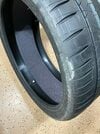Indeed, as do I.
Reading the history of that fiasco shows that many people "in the business" could have saved so many lives if they had just raised a stink, and KEPT raising a stink, once the first failures became known. (That's why this thread is so important . . . especially PICTURES!)
But they didn't and what a train wreck it became for Ford, Firestone/Bridgestone, and all that were killed or injured.
I keep banging the drum on this issue as you do NOT want to be there when a tire comes apart at high speed . . . it's a whole bunch of "not good."
The details are worth a read; one would think this would be part of mandatory training on the first day for all going to work at a tire retailer or manufacturer, but I guess it's not given that everyone at Tesla and Michelin (and tire retailers) appears to be doing very little (or nothing) on these tire failures, perhaps until there's an accident or three (and I sure hope I'm wrong):

en.wikipedia.org
The
Firestone and Ford tire controversy of the 1990s saw hundreds of people die in automobile crashes caused by the failure of
Firestone tires installed on light trucks made by
Ford Motor Company.
Unusually high failure rates of P235/75R15 ATX, ATX II, and Wilderness AT tires installed on the
Ford Explorer and similar vehicles were found to have caused crashes that killed 271 people and injured more than 800 others in the United States alone; more died in other countries.
[1][2] The revelations led Ford and
Bridgestone, owner of the Firestone brand, to recall 14.4 million tires in the United States in August 2000, and more in international markets.
[1][2]
The revelations halved the market value of Bridgestone, which fired or accepted the resignation of several executives and closed the
Decatur, Illinois, factory where the tires were manufactured.
[3] Ford also fired or accepted the resignation of executives. Each company publicly blamed the other for the defects, a disagreement that brought an end to the companies' nearly 100-year relationship.
[4]
Congressional inquiry into the scandal led to the enactment of the
Transportation Recall Enhancement, Accountability and Documentation (TREAD) Act in October 2000.
[5]
[truncated]
*****************************
Ditto for the Toyota floor mat fiasco that cost them billions, killed dozens, and could have been completely avoided IF a receptionist at a San Diego Lexus dealer had been given the most basic of training regarding the actions to take with
any customer safety concern . . . but she wasn't.
At the early states of this disaster, the previous driver of a loaner Lexus ES350 reported, face-to-face, that the gas pedal got caught under the floor mat. IIRC, the how-can-you-possibly-be-so-stupid receptionist didn't do anything about it. The car was loaned out again; four people burned to death in the subsequent high-speed accident. Common sense isn't very common . . . .
From Wiki:
On September 26, 2007, Toyota recalled 55,000 sets of heavy-duty rubber floor mats for the
Toyota Camry and
Lexus ES 350 sedans.
[6] The recalled mats were of the optional "all-weather" type. The
NHTSA stated that the recall was due to the risk that unsecured mats could move forward and trap the gas pedal.
[6]
On August 28, 2009, a two-car collision killed four people riding in a Lexus dealer-provided loaner
ES 350 in
San Diego, California; the accident was caused by the Lexus' incorrectly having been fitted with all-weather rubber floor mats meant for the
RX 400h SUV, and the fact that these mats were not secured by either of the two retaining clips.
[7] Additionally, the brake hardware showed signs of heavy braking consistent with a stuck accelerator pedal.
[7] The investigators' report stated that the accelerator pedal's hinge did not allow relieving of obstructions, and the dashboard lacked directions for the three-second emergency press of the
push button keyless ignition. NHTSA investigators also recovered the accident vehicle's accelerator pedal, which was still "bonded" to the SUV floor mat.
[7]
Which lead to billions in avoidable losses:

en.wikipedia.org
***************************
Let's nip this in the bud: please keep posting pictures of your delaminating Michelin 21" tires.
Thanks!





